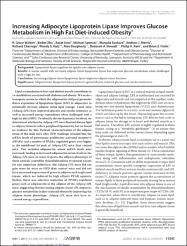Increasing Adipocyte Lipoprotein Lipase Improves Glucose Metabolism in High Fat Diet-induced Obesity

Göster/
Tarih
2015Yazar
Walton, R. GraceZhu, Beibei
Ünal, Reşat
Spencer, Michael
Sunkara, Manjula
Morris, Andrew J.
Finlin, Brian S.
Üst veri
Tüm öğe kaydını gösterÖzet
Lipid accumulation in liver and skeletal muscle contributes to co-morbidities associated with diabetes and obesity. We made a transgenic mouse in which the adiponectin (Adipoq) promoter drives expression of lipoprotein lipase (LPL) in adipocytes to potentially increase adipose tissue lipid storage. These mice (Adipoq-LPL) have improved glucose and insulin tolerance as well as increased energy expenditure when challenged with a high fat diet (HFD). To identify the mechanism(s) involved, we determined whether the Adipoq-LPL mice diverted dietary lipid to adipose tissue to reduce peripheral lipotoxicity, but we found no evidence for this. Instead, characterization of the adipose tissue of the male mice after HFD challenge revealed that the mRNA levels of peroxisome proliferator-activated receptor-gamma (PPAR gamma) and a number of PPAR gamma-regulated genes were higher in the epididymal fat pads of Adipoq-LPL mice than control mice. This included adiponectin, whose mRNA levels were increased, leading to increased adiponectin serum levels in the Adipoq-LPL mice. In many respects, the adipose phenotype of these animals resembles thiazolidinedione treatment except for one important difference, the Adipoq-LPL mice did not gain more fat mass on HFD than control mice and did not have increased expression of genes in adipose such as glycerol kinase, which are induced by high affinity PPAR agonists. Rather, there was selective induction of PPAR gamma-regulated genes such as adiponectin in the adipose of the Adipoq-LPL mice, suggesting that increasing adipose tissue LPL improves glucose metabolism in diet-induced obesity by improving the adipose tissue phenotype. Adipoq-LPL mice also have increased energy expenditure.

















